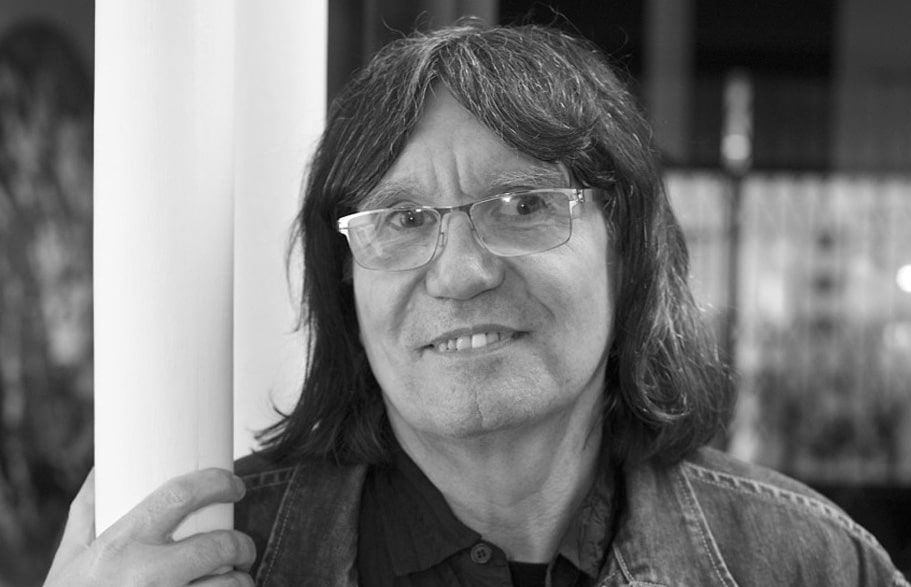The Anaesthsia of Violence
Working on a variety of perceptual levels, Philippe Huart lets one visit his intimate diary entries or take a tour of his fantasies. His canvases suggest several different readings – aesthetic, message-laden, lyrical, or realistic in a fictional take on the everyday – so as to account for both the uniformity and the disorder of the visual information that is bombarding us.
Whether he is depicting a gun, bonbons, flowers, or pharmaceutical tablets, Huart's concern is not to reveal, through his iconography, what grounds the established metaphorical relations between objects, and that just makes them more fascinating. The painter favors reflective surfaces on which the surrounding spectacle, out of frame, comes to fit like a film on the screen.
Starting with Pop Art-related imagery, he creates a universe populated with gleaming capsules, tired flowers, and tangy candy treats. His sumptuous sweets are piled up, packed in, juxtaposed, enlarged, and fragmented. From the initial photographic document he removes those anecdotal features that might risk diverting one's attention from the main subject matter of the composition. It is the treatment of the image, with all the attendant ambiguities of representation, that interests him.
His work clings to the high-definition zones of images. But his canvases have little to do with their appearance or the objects being represented. They constitute, instead, a set of motivations and propositions.
Thus, beneath their tempting colors, these capsules the painter prescribe do not conceal their pernicious side-effects, which, on account of their attractiveness, might otherwise be forgotten.
Dependence on these new Gidean "Fruits of the Earth" reveals the critical import of his work as well as its genuinely disturbing power.
While the highly strict symmetry of his paintings – which divides the canvas in half lengthwise, thereby offering two realities that answer each other like a reflected image – affords one an idea of the sometimes extreme rigorousness of this approach, it no less remains the case that there is also room for humor, as the titles chosen for these pictures demonstrate. Through the reflections they give off (and as reinforced by the titles they are given, often in homage to 1970s Pop music), his works show display great complexity in his arrangement of graphic elements.
It seems that the artist is less interested in a faithful reproduction of the image than in the optical illusion it represents. In this fake naturalism, the glossy perfection of what is being depicted borrows from the craftsmanship of this former advertising professional. His approach to the subjects of his paintings is conceptual, and he introduces words that put writing in a representational role as he combines text and images in a variety of ways that are always executed with a certain amount of finesse. He still loves the reflections of the outside world on the chrome-plated surfaces of revolvers, sugar-coated pills, or translucent candy wrappers... His taste for physical effects, his brush strokes, and his glazes are masterfully and knowingly expressed in a way that is reminiscent of the painters of Dutch still lifes. The miraculous meeting of panache and finish found in these harmonious volumes and colors gives his compositions a rhythmic perfection that is fascinatingly unique.
The perfect finishing strokes on his works remove from them any purely philosophical, social, or protest message, though they also allow one to see through their insidious violence. Huart concentrates his efforts on a near-anaesthetizing, almost stupefying level of pictorial investigation where the meaning contained in the image spawns comparisons to conceptual artists. Paradoxically, his vibrantly polychromatic work reflects a quite somber, emotionally moving tonality that seems deeply marked by death.
His painting is invigorated by intentions, or rather provocations, that do not represent, but instead create, another reality, one to which each viewer, depending on her experiences, emotions, and cultural background, can bring her own sensitive or cognitive response.
Renaud Faroux, Paris
Det bedövande våldet
Philippe Huart arbetar på flera perceptionsnivåer och låter oss ta del av hans levnadshistoria eller göra en rundvandring bland hans fantasier. Hans målningar kan tolkas på flera sätt: estetiskt, som förmedlare av budskap, lyriskt eller realistiskt i en vardagsskildring för att upptäcka hur likformig och oordnad den visuella informationen som sköljer över oss är.
Hans bildspråk avslöjar inte de metaforiska sambanden mellan föremålen och det gör dem bara mer fascinerande vare sig det handlar om pistoler, karameller, blommor eller medicinkapslar ... Målaren föredrar blanka ytor där det som händer runt omkring, utanför bilden, fastnar som film på en skärm.
Han utgår från bilder som knyter an till popkonsten och skapar en värld av blänkande kapslar, vissna blommor och syrliga karameller. Hans läckerheter samlas ihop, staplas, sätts samman, förstoras och splittras. Huart avlägsnar de anekdotiska elementen från den fotografiska utgångsbilden, så att uppmärksamheten koncentreras på målningens huvudföremål. Det är bildbehandlingen som intresserar honom med bildåtergivningens alla tvetydigheter.
Hans verk är som högupplösta bilder. Men målningarna har inte mycket att göra med det de föreställer eller de föremål som avbildas. Målningarna är snarare en samling motiveringar och förslag.
Kapslarna som målaren förskriver döljer inte biverkningarna eller de skadliga effekterna som annars skulle kunna ignoreras bakom de läckra färgernas dragningskraft. Beroendet av denna, enligt André Gide, nya "Jordiska föda" avslöjar verkets kritiska hållning och verkliga förmåga att oroa.
Den skarpa symmetrin som delar duken mitt av och visar två verkligheter som motsvarar varandra likt en reflekterad bild upplevs ibland extremt hård men det finns också plats för humor vilket tavlornas titlar visar. Hans verk väcker oväntade tankar (förstärkt av titlar som ofta refererar till 1970-talets popmusik), med hjälp av rikligt varierade grafiska element.
Konstnären verkar vara mindre intresserad av den trogna bildåtergivningen än av bildens optiska illusion. Tavlornas glänsande fulländade resultat ger ett falskt naturtroget intryck som kommer från hans teknik som gammal reklamman. Subjektet behandlas konceptuellt med ord inskrivna som bilder för att koppla ihop text och bild på olika sätt, alltid med en viss sinnrikhet. Han tycker om när omvärlden reflekteras på färgstarka ytor av pistoler, tabletter och genomskinliga skrynkliga karamellpapper… Hans smak för materialets effekter, hans penseldrag och lager av lasyr, känns behärskade och omsorgsfulla och påminner om de holländska stillebenmålarna. Det fantastiska mötet mellan lekfullhet och finish i harmoni med volym och färg ger hans kompositioner en mycket spännande rytm.
Den perfekta ytan lyfter bort alla rent filosofiska, sociala och anspråksfulla budskap och släpper lös det lömska våldet. Huart koncentrerar sig på en nästan förlamande och bedövande utforskande nivå där bildens betydelse gör att han står konceptkonstnärerna nära. Hans vibrerande färgstarka konst består paradoxalt nog av känslosamma, mycket dämpade, toner, som tycks vara djupt märkta av döden.
Hans målningar är fyllda av avsikter eller snarare av provokationer som inte föreställer något utan skapar en annan verklighet som betraktaren själv får reagera på, medvetet eller kognitivt beroende på erfarenhet, känsloladdning och kultur.
Renaud Faroux, Paris
Anesthésie de la violence
Philippe Huart travaille sur différents niveaux de perception et donne à visiter ses carnets de vie ou à faire le tour de ses fantasmes. Plusieurs lectures sont suggérées par ses toiles : esthétique, porteuse de messages, lyrique ou réaliste dans une fiction du quotidien pour rendre compte de l'uniformité et du désordre des informations visuelles qui nous bombardent.
Son iconographie a le souci de ne pas dévoiler ce qui fonde les rapports métaphoriques établis entre les objets et ne les rend que plus fascinants qu'il s'agisse d'un revolver, de bonbons, de fleurs, de cachets pharmaceutiques... Le peintre privilégie les surfaces réfléchissantes où le spectacle alentour, hors champ, vient s'inscrire comme un film sur l'écran.
Parti d'une imagerie reliée au Pop Art, il crée un univers peuplé de gélules rutilantes, de fleurs fatiguées, de confiseries acidulées. Ses somptueuses douceurs sont accumulées, entassées, juxtaposées, grossies et fragmentées. Du document photographique initial, il retire les éléments anecdotiques qui risqueraient de détourner l'attention du sujet principal de la composition. C'est le traitement de l'image qui l'intéresse avec toutes les ambiguïtés de la représentation.
Son oeuvre s'attache à des zones de hautes définitions de l'image. Mais ses toiles n'ont pas grand chose à voir avec leur apparence ou les objets représentés. Elles constituent plutôt un ensemble de motivations et de propositions.
Ainsi les gélules que le peintre prescrit ne dissimulent pas sous leurs couleurs alléchantes les effets secondaires et pernicieux que leur attirance voudrait faire ignorer. La dépendance à ses nouvelles Nourritures Terrestres dévoile la portée critique de l'oeuvre et son authentique pouvoir de perturbation.
Si la symétrie la plus rigoureuse, coupant la toile par le milieu et proposant deux réalités qui se répondent comme une image reflétée, permet de concevoir la rigueur parfois extrême de cette démarche, il n'en reste pas moins que l'humour y a aussi sa place comme le prouve les titres des tableaux. Ses oeuvres ouvrent par le biais des réflexions (renforcées par les titres souvent en hommage à la musique Pop des années 1970), sur une grande complexité des éléments graphiques mis en place.
Il semble que l'artiste est moins intéressé par la reproduction fidèle de l'image que par l'illusion optique qu'elle représente. Dans ce faux naturalisme, la perfection glacée du rendu des tableaux emprunte à sa technique d'ancien professionnel de la publicité. Il a une approche conceptuelle du sujet et introduit des mots mettant l'écriture en représentation pour conjuguer texte et images de manière variée, toujours avec une certaine finesse. Il aime toujours les reflets du monde extérieur sur les surfaces chromées des revolvers, des dragées, ou les froissures translucides des papiers de bonbons... Son goût des effets de matière, ses coups de brosses, ses glacis, s'expriment avec une maîtrise et une science qui évoquent les peintres des natures mortes hollandaises. La miraculeuse rencontre du brio et du fini dans l'harmonie des volumes et des couleurs donne à ses compositions une perfection rythmique d'une fascinante singularité.
Leurs finitions parfaites leur ôtent tout message purement philosophique, social ou revendicatif mais laissent percer leur insidieuse violence. Huart se concentre sur un niveau de recherches quasi anesthésiantes, stupéfiantes où la signification de l'image le rapproche des artistes conceptuels. Son travail d'une vibrante polychromie reflète paradoxalement une émouvante tonalité, très sombre, qui semble profondément marquée par la mort.
Sa peinture est animée d'intentions ou plutôt de provocations qui ne représentent pas mais créent une autre réalité à laquelle le spectateur apporte sa propre réponse sensible ou cognitive selon l'expérience, l'affectivité ou la culture de chacun.
Renaud Faroux, Paris



